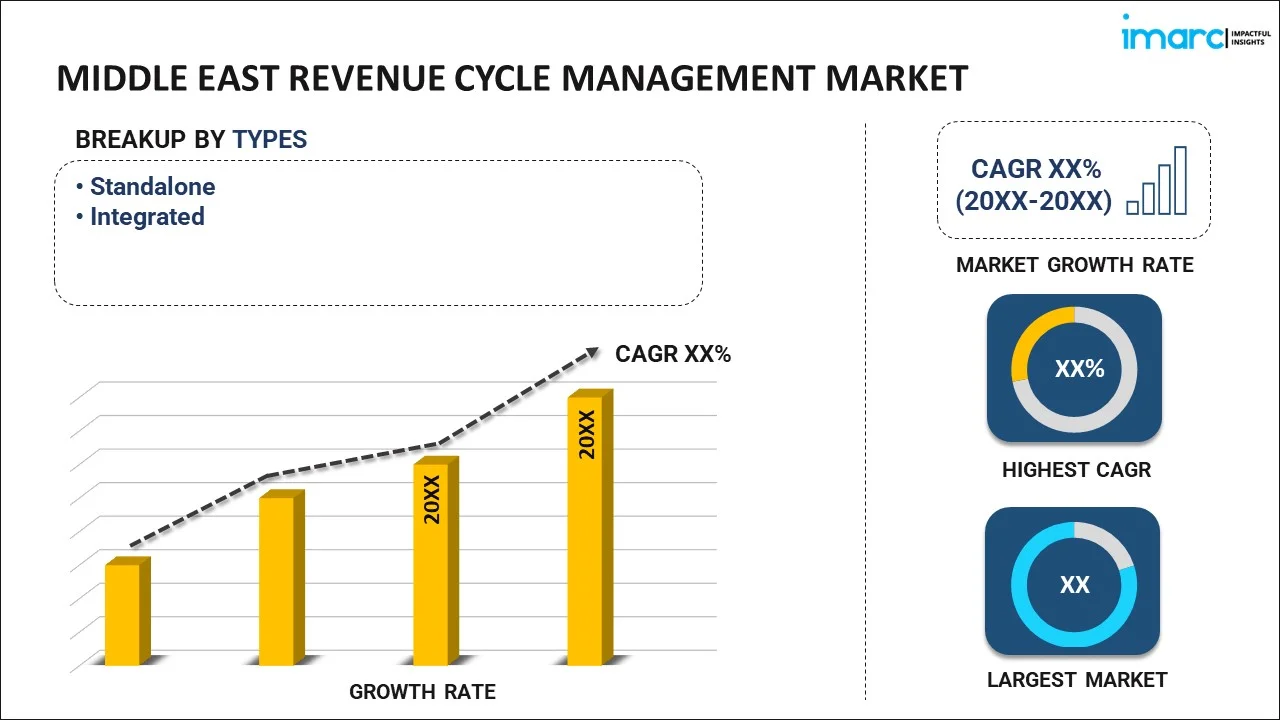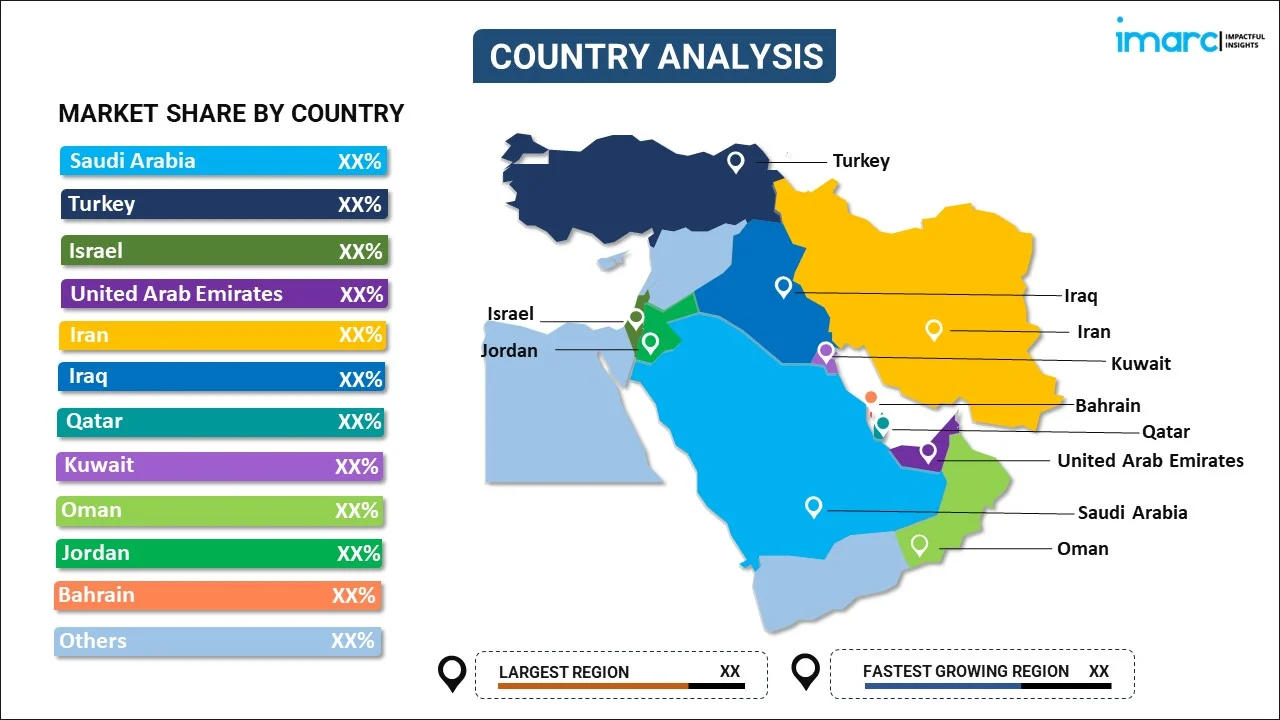
Middle East Revenue Cycle Management Market Report by Type (Standalone, Integrated), Component (Software, Services), Deployment (Web-based, Cloud-based, On-premises), End User (Hospitals, Physicians, Diagnostic and Ambulatory Care Centers), and Country 2026-2034
Market Overview:
Middle East revenue cycle management market size reached USD 7,361.2 Million in 2025. Looking forward, IMARC Group expects the market to reach USD 19,068.0 Million by 2034, exhibiting a growth rate (CAGR) of 11.15% during 2026-2034. The emerging shift from fee-for-service to value-based care models that emphasizes the quality and outcomes of healthcare services, is driving the market.
|
Report Attribute
|
Key Statistics
|
|---|---|
|
Base Year
|
2025
|
|
Forecast Years
|
2026-2034
|
|
Historical Years
|
2020-2025
|
|
Market Size in 2025
|
USD 7,361.2 Million |
|
Market Forecast in 2034
|
USD 19,068.0 Million |
| Market Growth Rate 2026-2034 | 11.15% |
Access the full market insights report Request Sample
Revenue cycle management (RCM) is a systematic approach that healthcare organizations use to track the financial aspects of patient care. It encompasses the entire patient journey, from appointment scheduling to the final payment of services. RCM involves various stages, including patient registration, insurance verification, charge capture, coding, billing, and payment collection. Efficient RCM ensures accurate and timely reimbursement for healthcare services, optimizing revenue for providers. Key components of RCM include coding accuracy, claims submission, denial management, and accounts receivable management. By streamlining these processes, healthcare providers can enhance financial performance, reduce claim denials, and improve overall cash flow. RCM also helps organizations comply with regulatory requirements and adapt to changes in healthcare policies, ultimately contributing to the sustainability and success of healthcare practices.
Middle East Revenue Cycle Management Market Trends:
The revenue cycle management market in the Middle East is witnessing robust growth, primarily fueled by several key drivers. Firstly, the increasing adoption of electronic health records (EHRs) across healthcare facilities has played a pivotal role in driving the demand for RCM solutions. As healthcare providers transition towards digitized systems, the need for efficient and integrated RCM solutions becomes paramount, enhancing the overall revenue capture and reimbursement processes. Moreover, the ever-evolving regulatory landscape in the healthcare industry serves as a significant catalyst for the RCM market. Stringent regulations and compliance requirements necessitate sophisticated RCM solutions that can adapt to dynamic changes, ensuring accuracy and adherence to complex billing and coding standards. Furthermore, the rising volume of healthcare data and the growing complexity of billing procedures underscore the importance of advanced RCM systems, driving market expansion. In addition to this, the increasing focus on cost containment and operational efficiency within healthcare organizations contributes to the growing adoption of RCM solutions. By streamlining revenue-related processes and minimizing billing errors, RCM systems empower healthcare providers to optimize financial performance. As the healthcare landscape continues to evolve, the regional RCM market is poised to flourish, driven by a confluence of technological advancements, regulatory imperatives, and the imperative to enhance financial outcomes in the healthcare sector.
Middle East Revenue Cycle Management Market Segmentation:
IMARC Group provides an analysis of the key trends in each segment of the market, along with forecasts at the regional and country level for 2026-2034. Our report has categorized the market based on type, component, deployment, and end user.
Type Insights:

To get detailed segment analysis of this market Request Sample
- Standalone
- Integrated
The report has provided a detailed breakup and analysis of the market based on the type. This includes standalone and integrated.
Component Insights:
- Software
- Services
A detailed breakup and analysis of the market based on the component have also been provided in the report. This includes software and services.
Deployment Insights:
- Web-based
- Cloud-based
- On-premises
The report has provided a detailed breakup and analysis of the market based on the deployment. This includes web-based, cloud-based, and on-premises.
End User Insights:
- Hospitals
- Physicians
- Diagnostic and Ambulatory Care Centers
A detailed breakup and analysis of the market based on the end user have also been provided in the report. This includes hospitals, physicians, and diagnostic and ambulatory care centers.
Country Insights:

To get detailed regional analysis of this market Request Sample
- Saudi Arabia
- Turkey
- Israel
- United Arab Emirates
- Iran
- Iraq
- Qatar
- Kuwait
- Oman
- Jordan
- Bahrain
- Others
The report has also provided a comprehensive analysis of all the major regional markets, which include Saudi Arabia, Turkey, Israel, United Arab Emirates, Iran, Iraq, Qatar, Kuwait, Oman, Jordan, Bahrain, and Others.
Competitive Landscape:
The market research report has also provided a comprehensive analysis of the competitive landscape. Competitive analysis such as market structure, key player positioning, top winning strategies, competitive dashboard, and company evaluation quadrant has been covered in the report. Also, detailed profiles of all major companies have been provided.
Middle East Revenue Cycle Management Market Report Coverage:
| Report Features | Details |
|---|---|
| Base Year of the Analysis | 2025 |
| Historical Period | 2020-2025 |
| Forecast Period | 2026-2034 |
| Units | Million USD |
| Scope of the Report | Exploration of Historical and Forecast Trends, Industry Catalysts and Challenges, Segment-Wise Historical and Predictive Market Assessment:
|
| Types Covered | Standalone, Integrated |
| Components Covered | Software, Services |
| Deployments Covered | Web-based, Cloud-based, On-premises |
| End Users Covered | Hospitals, Physicians, Diagnostic and Ambulatory Care Centers |
| Countries Covered | Saudi Arabia, Turkey, Israel, United Arab Emirates, Iran, Iraq, Qatar, Kuwait, Oman, Jordan, Bahrain, Others |
| Customization Scope | 10% Free Customization |
| Post-Sale Analyst Support | 10-12 Weeks |
| Delivery Format | PDF and Excel through Email (We can also provide the editable version of the report in PPT/Word format on special request) |
Key Questions Answered in This Report:
- How has the Middle East revenue cycle management market performed so far and how will it perform in the coming years?
- What has been the impact of COVID-19 on the Middle East revenue cycle management market?
- What is the breakup of the Middle East revenue cycle management market on the basis of type?
- What is the breakup of the Middle East revenue cycle management market on the basis of component?
- What is the breakup of the Middle East revenue cycle management market on the basis of deployment?
- What is the breakup of the Middle East revenue cycle management market on the basis of end user?
- What are the various stages in the value chain of the Middle East revenue cycle management market?
- What are the key driving factors and challenges in the Middle East revenue cycle management?
- What is the structure of the Middle East revenue cycle management market and who are the key players?
- What is the degree of competition in the Middle East revenue cycle management market?
Key Benefits for Stakeholders:
- IMARC’s industry report offers a comprehensive quantitative analysis of various market segments, historical and current market trends, market forecasts, and dynamics of the Middle East revenue cycle management market from 2020-2034.
- The research report provides the latest information on the market drivers, challenges, and opportunities in the Middle East revenue cycle management market.
- Porter's five forces analysis assist stakeholders in assessing the impact of new entrants, competitive rivalry, supplier power, buyer power, and the threat of substitution. It helps stakeholders to analyze the level of competition within the Middle East revenue cycle management industry and its attractiveness.
- Competitive landscape allows stakeholders to understand their competitive environment and provides an insight into the current positions of key players in the market.
Need more help?
- Speak to our experienced analysts for insights on the current market scenarios.
- Include additional segments and countries to customize the report as per your requirement.
- Gain an unparalleled competitive advantage in your domain by understanding how to utilize the report and positively impacting your operations and revenue.
- For further assistance, please connect with our analysts.
 Request Customization
Request Customization
 Speak to an Analyst
Speak to an Analyst
 Request Brochure
Request Brochure
 Inquire Before Buying
Inquire Before Buying




.webp)




.webp)












